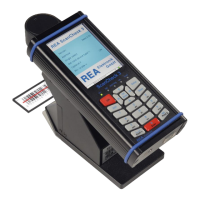Operating Manual Page 56 / 116 Copyright © REA Elektronik
REA ScanCheck 3n
V 1.2.0 24/02/2020
5.1 Handling the REA ScanCheck 3n
The following operating instructions must be adhered to in order to obtain comparable
and repeatable measurement results.
1. The laser beam must cross the bar code bars at an angle of 90°. If this is not the case, the
device displays the bar code size incorrectly.
2. The bar code pattern must lie flat under the device. If this is not the case, the contrast
results change. Metallic and other shiny materials are especially critical.
3. The distance to the bar code must always remain the same. The ideal distance is given if
the REA ScanCheck 3 is standing directly in front of the calibration code, as on the
calibration card.
4. Measurements in direct sunlight or with cast shadows in the measuring area must be
avoided because the measurements will be corrupted. Direct irradiation with directed light
from desk lamps or halogen lamps (or comparable LED room lighting) is also not allowed.
5. If the ambient light changes, i.e. the measuring location changes, recalibration is required.
Critical are light changes from light with a high proportion of red/infra-red light to light types
with a low proportion of red/infra-red light (e.g. the change from daylight to neon light).
6. An area of approx. 30 cm should be kept clear in front of the REA ScanCheck 3n!
If a light/dark wall is present in this area for example, this will change the contrast results.
7. The bar code to be tested should be centred in front of the REA ScanCheck 3n, to obtain
the best possible measuring accuracy.
8. If more than one code is located in the scan area, the first code from the left is always
captured and measured. Therefore it may be necessary to cover codes so the wanted code
is actually measured.
9. Translucent materials (e.g. plastic sheets) must always be measured on a defined underlay.
ISO/IEC 15416 recommends a black underlay with a reflection of a maximum of 5%.
10. The REA ScanCheck 3n must not fall or be exposed to violent impacts. This may cause
damage to the device.
11. Regular calibration (test equipment monitoring) is required in order to ensure the REA
ScanCheck 3n supplies correct measurement results.
12. The REA ScanCheck 3n must never be calibrated with the extension panels installed,
because the cut-outs in the panel will distort the calibration.
13. If the REA ScanCheck 3n is not in use, it should be stored in the transport packaging or
covered with a cloth (anti-static, if possible) to protect it from dust.

